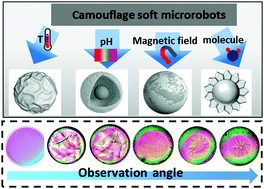Deformable, sensible, and reconfigurable microgels with structural color: potential as camouflage soft microrobots†
Abstract
Camouflage soft microrobots that undergo controlled shape and optical changes in response to a range of stimuli are of interest in microscale soft robotic and biomedical devices. The materials that such microbots require must possess excellent mechanical properties and special optical properties. In this paper, a calibrated droplet was constructed by droplet microfluidics, which served as a stimuli-responsive, semi-confined space to process block copolymer (BCP) self-assembly. This unique confined space allows block copolymers to respond to stimuli (pH, temperature, and magnetic energy), generating a series of topologically heterogeneous microgels (THGMs) with a soft nature. This soft property endows the THGMs with superior deformability, sensitivity and reconfigurability: three essential elements of soft microrobots. Simultaneously, the topological microstructures endow the THGMs with vivid iridescence and a broad color appearance, which is derived from the combined grating dispersion and film interference. Such synergistic color-changing, shape-morphing and stimuli-sensing capabilities have been integrated into a microscale entity for the first time, yielding a multifunctional synergy towards more powerful soft robotics (e.g. camouflaged robots). This work has made color-changeable soft machines accessible, and is expected to hold wide potential application in biomimetic soft robotics, biological sensors, and camouflage.



 Please wait while we load your content...
Please wait while we load your content...